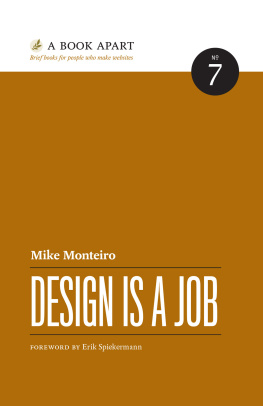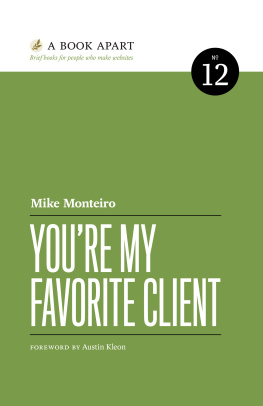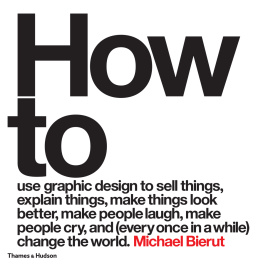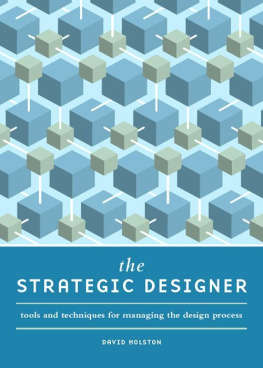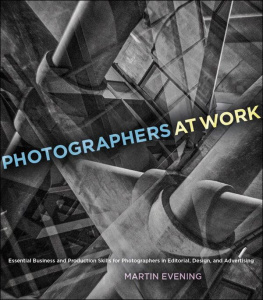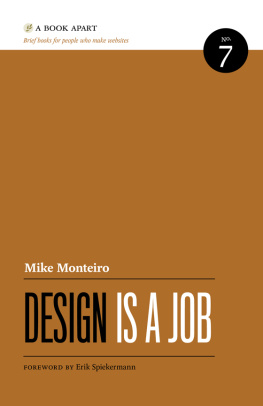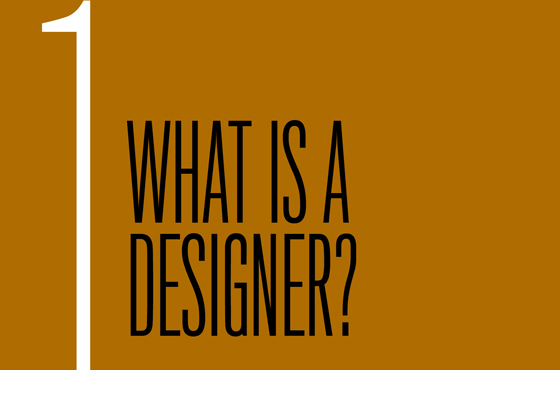ONLINE AND OFFLINE , Mike Monteiro is known as a straight talker. He is a living bullshit detector and will not suffer fools. I believe this is because he started his career by making logos in thirty minutes for a copy shop in Austin, without prior qualifications. Fear of discovery is terrible, but it keeps you on your toes. I should know: I started out making logos in thirty minutes for a small printshop in Berlin, without prior qualifications as a graphic designer. So Mike and I know bullshit when we see and hear it, having been quite good at it for a while ourselves.
Being a designer is all about attitude. Sure, you have to know your craft, but as we both found out, you can pick most of that up over time if youre prepared to listen, watch, and learn. Without the right attitude, however, youll always be a vendor to some people, a crazy artist to others.
Clients need to understand that theyve hired us to do something they are not good at. And that they need to pay us for our knowledge, skills, experience and, yes: attitude. To be referred to as one of those creative types is to be written off as intellectually inferior.
Contrary to popular belief, designers are not artists. We employ artistic methods to visualize thinking and process, but, unlike artists, we work to solve a clients problem, not present our own view of the world. We thrive on constraints, but we hate compromise. If a design project is to be considered successfuland success is the true measure of qualityit must not only add an aesthetic dimension, but solve the problem at hand.
This book will teach you how to be part of a service industry without becoming a servant. My advice, now and always, is learn, learn, learnstarting right here.
INTRODUCTION
I LOVE DESIGN.
I love it when something is well-designed. I love the process of getting there. I love the interesting failures along the way. I love that I have the opportunity to earn a living designing things at a place that my partner and I built from the ground up. I love the arguing and the critiques. I love that someone I hired three years ago can now make my designs better. And I absolutely love the clients who make this possible.
Which leaves you. I love you most of all. And I am tired of seeing you get your ass kicked because no one taught you better. I am tired of you not getting paid. I am tired of you working nights and weekends. I am tired of you doing spec work because someone has convinced you it will look good in your portfolio. I am tired of you sitting by and hoping the work sells itself.
So I wrote you a book. It has a spine and by the time youre done reading so will you.
This book is a guide to making a living as a designer. It contains the fundamentals of being a working designer, including working with clients and others, valuing your work, and getting paid. This book will look at ways to communicate and apply these fundamentals to every aspect of your job. The goal is to expand your view of your job as a designer to include not just your talent, but the business and communication aspects as well.
I made it a short book so you can get back to work.
This book does not contain a system. At the end of this book you will not run out to buy forty-three index cards. You will not get real. You will not add five items to your bucket list. You will not have to adjust your social media strategy, nor will you unlock a secret. You will have more confidence in yourself and a deeper understanding of your craft.
Why listen to me?
Ive been running Mule Design, along with my partner Erika Hall, for almost ten years. Before that I worked at startups, in-house marketing departments, and for other studios. Ive been a freelancer, a contractor, and possibly the worlds worst employee. I totally lied about being qualified for the first design job I ever got, making logos in thirty minutes for the desktop publishing department of a local copy shop in Austin, Texas. I spent years freaking out that someone would finally figure out I had no idea what I was doing.
I started my own design studio for a few reasons. First, I was a terrible employee. I was convinced I could run a design studio better than anyone Id ever worked for, and I wasnt sure why they had such a difficult time doing it. (Turns out the problem they all had in common was me.)
Second, I wanted control over the kind of clients I worked with. Its my belief that as a designer you are responsible for what you put into the world. When you work for someone else you cant always pick and choose what you work on. We very consciously keep Mule small so we never feel we have to take on a job we cant ethically stand behind just to keep the lights on.
Third, I found a good partner. And I wanted to keep working with her.
Along the way we made every possible mistake we could make. We worked for free. We kept working through shifting strategy. We sat back and waited for the phone to ring. We got shafted. We lost bids for stupid reasons. We worked without contracts. I have made every mistake I am telling you not to make in this book. And I guarantee that youll make mistakes as well. If not the same ones I did, youll find new and better ones. Because getting good at what you do doesnt come from not making mistakes; it comes from getting up off the floor after you fall down, and then putting up a warning sign so others avoid the pothole you fell into. This book is my warning sign to you.
Because I want you to do better. And work your ass off. And benefit accordingly. Because design is a job.
Why this book is for you
Obviously, try as I might to be balanced, Im coming at all of this from a bias of client services. And web design. Its what I do. But whether youre in client services, or a freelancer, working at a startup, or a big company, youll learn something from this book. Heck, you dont even have to be a designer to get something out of this. Whether you call yourself a visual designer, a graphic designer, a web designer, an interaction designer, a photographer, a casual blogger, or a modern dance enthusiast, there will be something in this book that will make you better at your craft.
BRING IN THE CREATIVES!
Let me tell you a beautiful story. You may be living it right now, you lucky dog. This story takes place in a beautiful far-away place with a deep blue sky, an ocean of green-screen possibilities, lollipop-trees dripping with inspiration, and the sensuous dance of exotic muses over the techno-thump of an ambient jungle soundtrack. Yum.
In this beautiful world there are no alarm clocks. After all, creativity demands sufficient sleep. You glide into work when you please, hopping and skipping past the insistent ogres that dare to schedule their beastly requirements meetings before 11 a.m. (theres no need to go to them after 11, either), and you slip into your Mirra chair, dismiss a few meeting requests on your 30 monitor, fire up iChat, and wait for inspiration to show itself.

